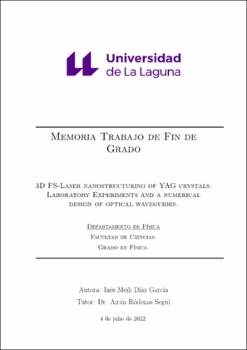3D FS-Laser nanostructuring of YAG crystals: Laboratory experiments and a numerical design of optical waveguides
Autor
Díaz García, Inés MeiliFecha
2022Resumen
En este trabajo de fin de grado se ha realizado un estudio de la fabricaci´on y aplicaci
´on de estructuras fot´onicas en 3D en las escalas nanom´etrica y microm´etrica.
Concretamente, el estudio se bas´o en el concepto de cristales fot´onicos y en gu´ıas de
onda ´opticas microestructuradas como objetivo tecnol´ogico. El proyecto comienza
definiendo el marco te´orico en el que est´an basadas estas estructuras de inter´es y
sus interacciones con factores externos, como puede ser la luz. Para ello, se ha
recurrido a conceptos te´oricos de estructuras peri´odicas que definen estos objetos
fot´onicos y se ha realizado un repaso de definiciones y ecuaciones relacionadas tanto
con el ´ambito del Electromagnetismo como con el de la ´ Optica. Adem´as, se ha
estudiado en detalle la t´ecnica experimental desarrollada para la fabricaci´on de un
patr´on peri´odico con nanoporos huecos en el material mediante la irradiaci´on l´aser
de pulsos de femtosegundos. Durante este trabajo, el material utilizado fue el cristal
de YAG. (“yttrium aluminium garnet”). Para lograr esto fue necesario el uso de diversos
dispositivos tecnol´ogicos como un l´aser de femtosegundos, un “pulse-picker”,
un sistema de nanoposicionamento 3D controlado por ordenador, un microscopio
´optico, un microscopio de electrones, una m´aquina de pulido ´optico, infraestructuras
de grabado qu´ımico h´umedo y adem´as, herramientas de simulaci´on num´ericas
(software comercial del BandSOLVE).
Una vez estudiada la t´ecnica de nanolitograf´ıa para la obtenci´on de nanoporos,
se procedi´o a la elaboraci´on de experimentos con la ayuda de la estudiante de tesis
doctoral PhD, Franzette Paz Buclatin. El objetivo era llevar a cabo un estudio sobre
las caracter´ısticas de esta t´ecnica de litograf´ıa basada en una t´ecnica descubierta por
el tutor Dr. R´odenas. Por tanto, se realiz´o un an´alisis para estudiar la dependencia
de la longitud de poros y su forma y tama˜no transversal submicrom´etricos en funci´on
de diferentes par´ametros del proceso de fabricaci´on como: el ritmo de repetici´on del
l´aser, energ´ıa de pulso o velocidad de escritura del l´aser. Para alcanzar este objetivo
se hizo uso del programa de procesamiento de im´agenes ImageJ. En este ´ultimo caso
fue necesario recurrir a servicios adicionales como el SEGAI para la utilizaci´on del
microscopio electr´onico de barrido.
Adem´as, durante este proyecto, tambi´en se utiliz´o el software BandSOLVE RSOFT.
La aplicaci´on de este software permiti´o poner en pr´actica los conocimientos te´oricos
sobre estructuras peri´odicas en un sencillo marco de simulaci´on num´erica. De esta
manera, fue posible realizar una optimizaci´on de una red hexagonal con el objetivo
de obtener las caracter´ısticas m´as adecuadas para el dise˜no y estudio de una gu´ıa de
ondas fot´onica, desde el rango del UV hasta el IR en el espectro electromagn´etico. El
rango electromagn´etico de inter´es fue limitado al rango de transparencia del YAG,
desde aproximadamente 250 nm (UV) hasta 5000 nm (mid-IR), para lo cual se tuvo
siempre en cuenta la dispersi´on del ´ındice de refracci´on del cristal. In this final degree project, a study of the fabrication and implementation of 3D photonic
structures at nanometric and micrometric scales was carried out. In particular,
the study was based around the concept of photonic crystals and microstructured
optical waveguides, as technology goal. It starts defining the theoretical framework
in which these structures of interest are based on and their interactions with external
factors, such as light. To do this, it was necessary to go to theoretical concepts
of periodic structures which define these photonic objects and a review of the Electromagnetism
and Optics definitions and equations has been done. Furthermore,
the experimental technique for fabricating a periodic pattern with hollow nanopores
in the material by means of femtosecond-pulse laser irradiation, has been studied.
During this project, the material which was used was YAG crystal (yttrium aluminium
garnet). To achieve this, it was necessary the use of different technological
devices such as a femtosecond-pulse laser, a pulse-picker, a computer controlled 3D
nanopositioning system, an optical microscope, an electron microscope, optical polishing
machine, wet-chemical etching infrastructure, and also numerical simulation
tools (commercial BandSOLVE software).
Once the nanolithography technique used for obtaining nanopores was studied, the
elaboration of experiments was carried out, also with the assistance of PhD student,
Franzette Paz Buclatin. The goal was to study the characteristics of this lithography
technique, which is based on a technique discovered by the supervisor Dr. R´odenas.
Therefore, an analysis was developed in order to study the dependence between the
pore length, and also its sub-micron cross-sectional shape and size, as a function of
some fabrication parameters such as: pulse repetition rate of the laser, pulse energy,
or laser writing speed. To achieve this objective, the use of the image processing
software ImageJ was needed. For this last task, it was necessary additional support
from SEGAI facilities with the purpose of using the scanning electron microscope
(SEM).
Also, through this project, the BandSOLVE RSOFT software was used. The implementation
of this software allowed to put into practice the theoretical knowledge
about periodic structures in an easy to use numerical simulation framework. Doing
this, it was possible to make an optimization process of an hexagonal lattice
with the purpose of obtaining the most suitable characteristics for designing and
studying a photonic waveguide, from the UV to the IR range in the electromagnetic
spectrum. The EM range of interest was limited to the transparency range of YAG,
from around 250 nm (UV) to 5000 nm (mid-IR), for which the dispersion of the
index of refraction of the crystal was always taken into account.





